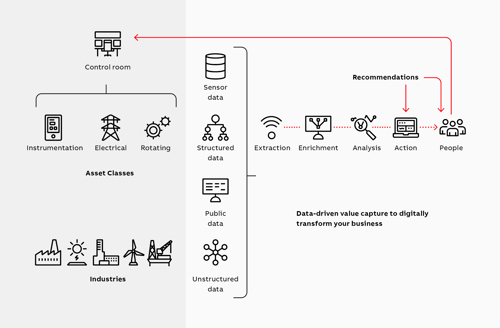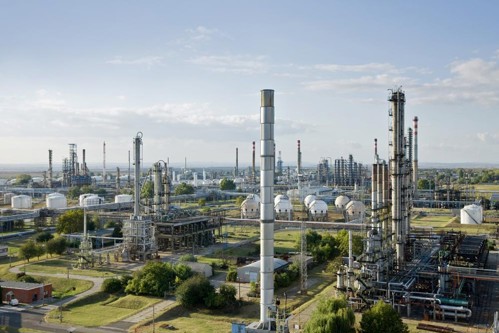Digital Feature: Driving chemical processing efficiencies using data-driven asset performance management
S. JONES, ABB, Lake Jackson, Texas
As the hydrocarbon processing industry (HPI) optimizes existing petrochemical and refining processes and adapts to innovations such as green hydrogen, digital and automation technologies are coming into their own.
Industry 4.0 solutions like artificial intelligence (AI), machine-learning (ML) and predictive analytics are revolutionizing the theory and practice of asset performance management (APM). Today’s quantitative risk analysis and current state of machine health solutions—often referred to as APM 4.0—can help HPI processors extract, collate and analyze their existing production data to drive efficiencies and reduce downtime, energy consumption and emissions.
Less than 20% of data generated by industrial companies is actually utilized—even less is analyzed. This means that up to 80% of data is simply lost.1 This article examines how new generation digital and automation platforms can be used to unlock the real value of contextualized data through the industrial internet of things (IIoT), improving industrial productivity and operational excellence.
The role of technology. Before we go into more depth about how this is done and with what specific technology platforms, let us begin by explaining the role of both wired sensor data and wireless sensors to carry out condition monitoring of critical assets like rotating, electrical and instrumentation.
Every industrial operator’s data historian and computerized maintenance management system (CMMS) contains a wealth of data on every facet of the enterprise’s production processes. This data is arguably the organization’s most valuable asset, but it can be difficult to access or is often not in the right format. Leveraging this information to help customers predict failures in real time and boost the reliability, availability, and maintainability of their critical equipment, is the goal of APM.
To solve this data usability problem, the author’s company uses an agnostic approach that leverages software adapters to convert data from customers’ systems into a format that can be understood by technology and collated in a single, central location—rather like the process of moving a Google email into Outlook. Once there, the technology uses a combination of advanced ML and AI approaches with first principles models—those based on the engineering design and physics behind the way a piece of equipment operates—to continuously evaluate the status of assets and predict potential issues.
For assets without wired sensors, retrofitting with wireless sensors is quick and easy. Once connected, the data can be analyzed with outputs/alarms accessible through email or dashboards on the company’s premise or in the cloud.2
The author’s company’s wireless smart sensor is agnostic, in that it can be attached to any company’s rotating equipment such as pumps, fans and compressors. The technology uses Bluetooth or WirelessHART communication to transmit production data from the edge through the plant data systems where it is used to analyze and to monitor asset health.2
Where asset health degradation is detected, an alert is then sent, and a potential failure mode and severity are assessed. Armed with this information, operations can investigate and close the loop by sending any required action to the CMMS, or directly back to the asset again via the distributed control system (DCS). Using the author company’s APM application, data from other rotating, electrical and instrumentation assets can all be monitored in the same place (FIG. 1).

Not all data is useful data. Having the right data at the right time is critical to achieving maintenance and reliability objectives.
With traditional run-to-failure (reactive), usage or time-based APM, which many operators still lean on for their maintenance requirements, machinery is only fixed when it fails or according to original equipment manufacturers’ (OEMs’) guidelines. The result is that asset failure directs the work, or the maintenance schedule dictates what personnel work on, potentially wasting time and budget.3
The author’s company employs a layered approach to APM incorporating two distinct APM 4.0 solutionsa,b. With the latter advanced prediction tier, customers get all the existing condition monitoring benefits plus the more sophisticated APM models for maintenance strategy optimization, execution lifecycle costing and root cause analysis to better secure more critical assets.
The author’s company breaks APM 4.0 into three distinct categories, beginning with condition monitoring, where operational technology (OT) data and sensors, pre-built asset models and detailed real-time workplace information are used to monitor known failure modes on electrical, rotating and instrumentation assets. The goal here is to start prioritizing maintenance activities based on data by leveraging condition monitoring at the edge or in the cloud.
The second category is advanced prediction, where deploying advanced predictive and prescriptive APM models becomes collaborative through the contribution of experts. Here, OT/information technology (IT)/engineering technology (ET) contextualized data is combined with rule based APM and AI/ML to create the highest level of protection for critical assets, combining events management, fault monitoring tools, recommendations and the ability to add work orders directly into the CMMS.
Finally, with maximum performance, a holistic view of asset performance, health, maintenance schedules and lifecycle costs are possible by connecting APM with existing work orders and operations management. In this scenario, historized asset health data and maintenance histories are incorporated to provide customers a 360° view of the performance of their assets. With this insight, maintenance trends can be analyzed and optimized.
At every level, it is important to keep the goals in mind: preventing failures, unscheduled downtime and reactive maintenance. How can I avoid manual intervention? How do I stop major failures before they happen? How do we enable an autonomous business process? How do we extend our maintenance intervals?
In the following section, we will examine how some of these APM 4.0 solutions have been applied to a real-world industrial project to drive efficiencies, add business value and—with optimized and sustainable downstream processing in mind—how APM can help reduce energy use and emissions.
Asset integrity, safety and sustainability. MOL Group employed the author’s company to deliver a 3-yr collaborative project to transform asset safety and reliability across four major chemical and refinery sites located in Hungary, Slovakia and Croatia (FIG. 2).

FIG. 2. View of MOL's Danube refinery.
The author’s company was tasked with improving asset performance across MOL’s downstream assets through standardizing processes and software, and ensuring maintenance management was focused on the right equipment. The overarching aim was to drive production efficiency, improve safety and reduce risk.
Leveraging technology and process data, the author’s company and their partnerc integrated a common digital platform at the Danube, Slovnaft and MOL Petrochemicals plants, and the INA chemical unit. The new solution incorporated improved maintenance management processes being rolled out by the author’s company to provide advanced risk analysis of assets to reduce unplanned outages and maintenance costs.
Put into action, MOL will increase availability and reduce turnaround duration, leading to estimated savings and production benefits of €10 MM/yr across its downstream assets.
As to the issue of sustainability, typically, most critical assets are also your biggest energy users. So, being able to improve the overall performance of an asset and monitoring where it sits on the performance curve, technology vendors can then optimize the overall energy spend, as well as help HPI companies avoid unplanned downtime, and minimize raw material use and waste, making APM 4.0 a win-win solution for downstream companies and the planet.
NOTES
a ABB Genix Predict
b ABB Genix APM 360
c Metegrity Visions
REFERENCES
1 ABB, “Revolutionize your operations with Genix: Empowering faster, better and smarter decisions,” 2023,online: https://new.abb.com/process-automation/genix
2 ABB, “ABB brings advanced analytics and enhanced asset performance into reach,” 2023, online: https://campaign-pa.abb.com/l/961062/2023-10-04/4ng9j
3 ABB, “ABB to deliver 10 million euros of production improvements for leading downstream operator,” September 30, 2020, online: https://new.abb.com/news/detail/68169/abb-to-deliver-10-million-euros-of-production-improvements-for-leading-downstream-operator






Comments